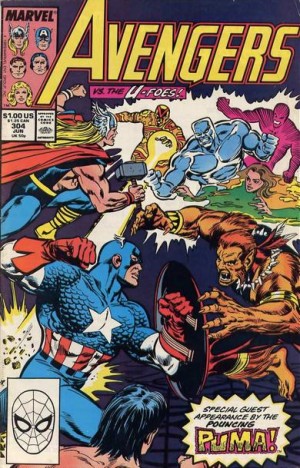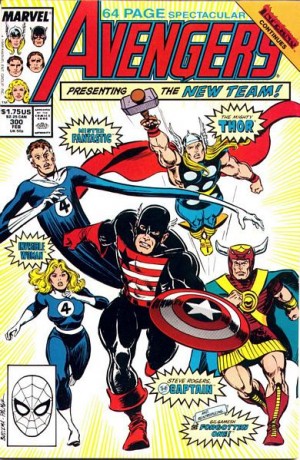The Avengers #288-304 (February 1988-June 1989)
Written by Ralph Macchio (#288-290, 300-303), Mark Gruenwald (#290, 301-303), Walter Simonson (#291-300), and Danny Fingeroth (#304)
Breakdowns by John Buscema (#288-300), Walter Simonson (#300), Bob Hall (#301), and Rich Buckler (#302-304)
Finishes by Tom Palmer (#288-300, #302-304),Walter Simonson (#300), and Don Heck (#301)
I've kind of fallen into rereading all of my Avengers issues, at least from the arbitrary starting point I picked back in the summer. The collection of books I discussed in the last two columns represent the high point of The Avengers in my childhood, and were the best that comic was until Kurt Busiek came along and fixed the extremely bad choices of the 1990s. The collection of issues I've picked for this column, however, represent a low point.
This batch was grouped due to the inconsistency in writing that happened between Roger Stern's legendary run, and John Byrne's largely forgotten one. None of these issues are to ever be considered iconic, and feel very constrained by some of the decisions being made in other Marvel comics (such as Captain America giving up his uniform and taking on the unique new name, The Captain). The team roster was shifting as often as the writer's credit, and for a couple of issues, the only Avengers team in existence was the West Coast one, not that they appeared all that often in the book.
To examine the main plot points, in bullet form:
- The Avengers
deal with the Super-Adaptoid's plans to take over the Cosmic Cube, after recruiting a number of robots to aid him, including Machine Man.
- Namor proves himself to be a very over-protective and domineering husband, refusing to allow Marrina to fight on the team, despite her always being around.
- The Cosmic Cube adopts the name Kubik, and looks really stupid.
- Marrina goes all feral at a party, turns into a gigantic worm, and starts wrecking ships at sea.
- In order to stop his wife, Namor uses the Black Knight's Ebony Blade to cut her, which causes the Black Knight to suffer from a curse (resulting in his having to wear a cumbersome exo-suit, and to become sharp to the touch somehow, as well as immobile).
- Doctor Druid becomes ever more critical of Captain Marvel's leadership, and begins to manipulate her.
- Captain Marvel takes a break after the fight with Marrina, and Druid manipulates (and psychically control) his fellow Avengers into making him chairman.
- We learn that Druid is himself being manipulated by Nebula, who has become part of the Kang Korps.
- Everyone ends up fighting one another at Nebula's behest, while she tries to retrieve a super weapon from a time bubble, or something like that.
- The Avengers basically break up after getting rid of Nebula and Druid.
- Jarvis is the only Avenger left, and he runs into some weird crap during Inferno, when all the payphones in Manhattan become demons.
- The Captain goes to suburban Connecticut to get help with the Inferno problem from Reed and Sue Richards, just to arrive after Nanny and the Orphan Maker (remember them?) kidnap Franklin Richards.
- While
fighting these ridiculous villains, Gilgamesh, the Forgotten Eternal shows up to help fight, just cause.
- The Captain (who almost immediately becomes Captain America again) decides, basically in some text pages, to hire a bunch of helpers for his new Avengers team, and we occasionally see some of these people, but their presence is never explained in any story.
- Super-Nova, a very large member of the Nova Corps decides that he's angry at Nebula for destroying the planet Xandar, so he comes to Earth to wreck it (apparently he thinks she's an Avenger).
- Quasar, the Fantastic Four (of which there are only three?) and the West Coast team fight him because the new East Coast team is fighting robot brain leech things in space.
- Captain America, Thor, and Gilgamesh hang out on Ellis Island, where they try to stop Puma from taking a kid from his tribe back home. That kid opens a portal to another dimension and the U-Foes show up to fight them.
These issues feature the following Avengers, many of whom leave the team for very poor reasons, story-wise:
- Captain Marvel (leaves after losing most of her energy)
- Doctor Druid (lost in the time-stream)
- Black Knight (becomes immobile, left behind in a protective energy field during Inferno, and not seen again)
- She-Hulk (leaves because she's embarrassed at being mind controlled)
- Namor (leaves after killing his wife)
- Thor
- Captain America/The Captain
- Nebula (although I don't think she was technically ever an Avenger)
- Mister Fantastic
- Invisible Woman
- Gilgamesh
None of these line-ups were exactly classic.
line-ups were exactly classic.
 line-ups were exactly classic.
line-ups were exactly classic.
One thing I noticed is that I'm not the only person revisiting this timeframe lately. In a recent issue of Avengers World, Dane Whitman, the Black Knight, is seen telling a bartender a story about himself being, basically, in a full-body cast during a battle. Also, in Mighty Avengers, when a boring mystic type (Kalluu? Something like that) talks for too long, She-Hulk remarks that he's just like Doctor Druid.
As I said, the writing here was very inconsistent. I wasn't surprised to find the issues that were hastily written after Roger Stern's departure to be lacking, but I would have expected a lot more from Walter Simonson, with these issues coming between his excellent runs on The Mighty Four and The Fantastic Four. Perhaps he never really wanted to take this job, as the stories really lacked enthusiasm. It's weird that even his Thor, the character he knew best at that time, felt forced and unnatural.
The art also began to suffer as John Buscema and Tom Palmer took some breaks (presumably out of exhaustion, after having drawn so many consecutive issues). A lot of the fill-in artists, such as Rich Buckler, Bob Hall, and Don Heck represent an earlier Marvel era, and they weren't adapting well to the transitional era that moved away from artists like Buscema, Byrne, and Romita Jr. towards people like Jim Lee and Todd McFarlane.
It's not hard to imagine, at a time when the X-Men were at the height of their popularity, that the Avengers were kind of an after-thought in the Marvel offices. That would explain the general malaise one gets from reading these issues. Was John Byrne able to turn it around when he came on the book? Find out next time!
 deal with the Super-Adaptoid's plans to take over the Cosmic Cube, after recruiting a number of robots to aid him, including Machine Man.
deal with the Super-Adaptoid's plans to take over the Cosmic Cube, after recruiting a number of robots to aid him, including Machine Man. fighting these ridiculous villains, Gilgamesh, the Forgotten Eternal shows up to help fight, just cause.
fighting these ridiculous villains, Gilgamesh, the Forgotten Eternal shows up to help fight, just cause.
No comments:
Post a Comment